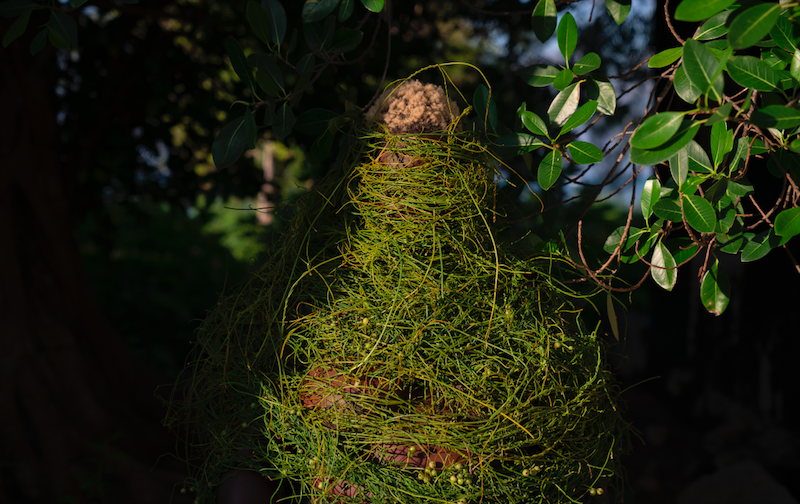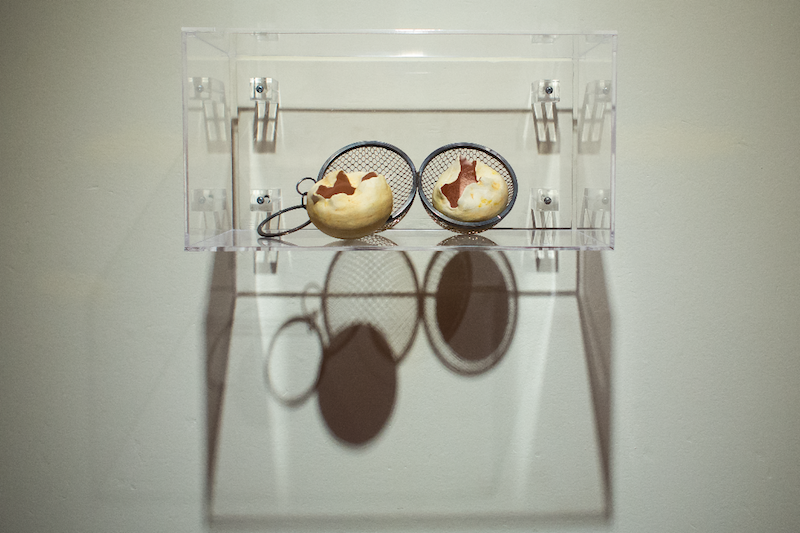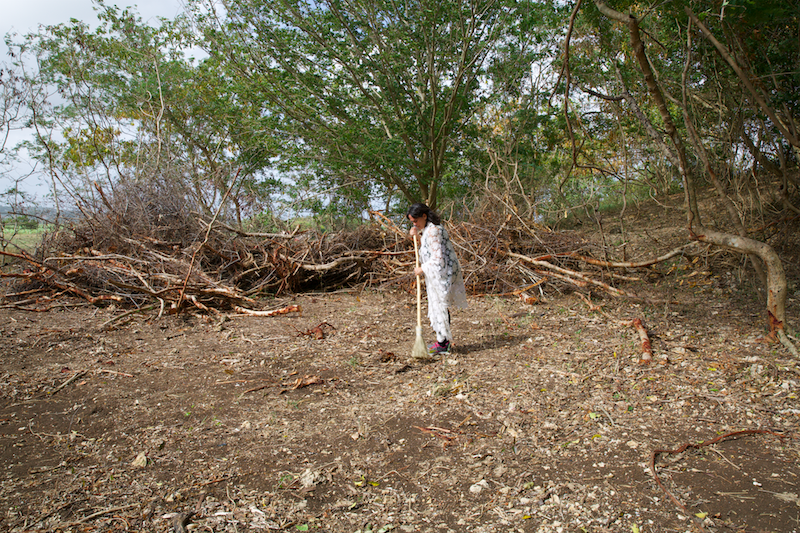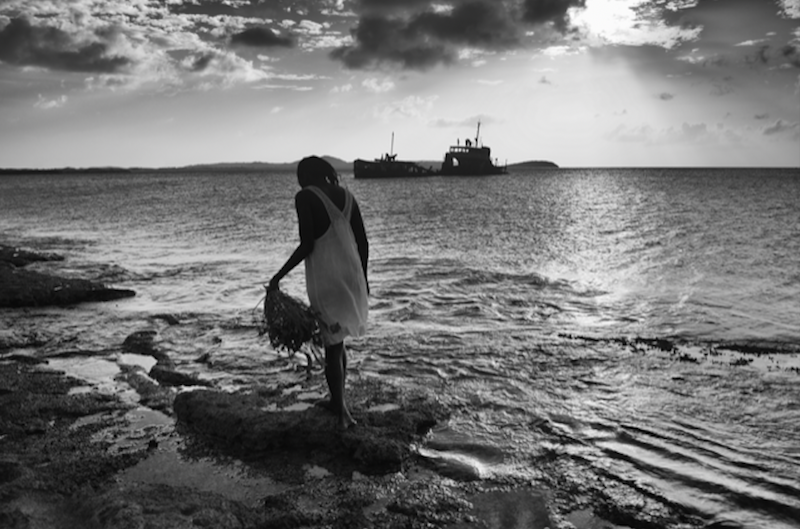
21.06.2021
Curator and spiritist Holly Bynoe reflects on the expansion of Obeah, a belief system of the Caribbean Black communities, and its relationship with women and their ancestral heritage to continue exercising care in the face of colonial extermination.

For Charlotte, Bessie, audre, and for all of our grandmothers who fought in silence
“This is the urgency: Live!
and have your blooming in the noise of the whirlwind.
Salve salvage in the spin.
Endorse the splendor splashes;
stylize the flawed utility;
prop a malign or failing light–
but know the whirlwind is our commonwealth.”
— Gwendolyn Brooks, The Second Sermon on the Warpland
I.
With the arrival of a new epoch, the Anthropocene,[5] the stage is set for horror, but the will, memory, gifts, and agency of our ancestors give us an opportunity to chart a new course and a path to the willingness of life.[6]
II.
“No action in the present is
an action planned with a view of its effect on the future.”
— Jamaica Kincaid, A Small Place
Our ancestors were revolutionaries, philosophers, creatives, Nobel laureates, activists, scientists, world-class professionals, and politicians with slippery tongues who called for truth, justice, protest, and equanimity during the dawning of our postcoloniality.[7] They comprise the Indigenous, bush doctors, witches, grandmothers and grandfathers full to the brim with lore and story, healers, magicians, sages, alchemists, ethnobotanists, and curanderos and curanderas making medicine from the land to help their communities heal. Others make medicine to cripple the inner workings of the plantation and its doctrines of white supremacy, racism, violence, and oppression.

In its mercurial vitality, Obeah provides us with ritualistic magic around the renegotiation of care; it provides tools of visualization and discipline to see beyond the remnants of empire and helps us envision the damage of Western dominance and indoctrination.
Its technology provides access to the sacred feminine energies of Mother Earth and is a tool through which we can heal generational and, in particular, colonial traumas. One of the most important aspects of Obeah is the acknowledgment of the ancestors and ancestral veneration. Another is the fact that at times, it can be so large and undefinable that it can encompass anything involving spirit and supernatural phenomena. However, it anchors the self within a lineage of ancestral energies—energies that are intangible, albeit powerful if one believes.

Each medicinal field of wild botanicals, every elixir, potion, and earthy concoction or rub contained that energy and that of all grandmothers before them. Despite lands being razed, partitioned, and controlled, the experience of the medicine lives on within blood; within the memory of our very beings. This is where Obeah, even if abstract, becomes very real. Despite the centuries of attack, extraction, and depletion, the Great Mother is all-powerful and able to heal herself through divine will and communication to continue the proliferation of medicines and healing.
Grandmothers have access to this regenerative power and have wielded it for centuries to survive and to thrive. Women artists are wielding that power to bring to life grandmothers of the past, some of which have crossed the watery grave in suspension, under pressure from the weight of history, unable to breathe. Yet they are still present through the remnants of stacked clay; their bones and marrow evidence of the survival and the trickery. Their wombs were places for negotiation, reason for which Obeah became an agent in the colonial construction of gender that positioned women within an evolving system of biopolitical control specifically targeting Black mothers.[13] It is worth highlighting that Obeah gave enslaved women the opportunity to control their reproductive capacities using the knowledge within African traditions, thereby giving them power to resist the theft of women’s reproductive labor and all-around productivity on the plantation.
III.
“Human beings are magical. Bios and Logos. Words made flesh, muscle, and bone animated by hope and desire, belief materialized in deeds, deeds which crystallize our actualities. And the maps of spring always have to be redrawn again, in undared forms.”
— Sylvia Wynter

Today, medicine continues to thrive despite bioprospecting and through a global war against climate collapse,[17] where we are seeing the swallowing and reclamation of low-lying territories and heritages by the sea. The vulnerabilities of Small lsland Developing States are exposed on a global stage[18] and the struggle to become medicine-secure is occurring in parallel with the advent of carbon credit markets[19] in a time where biodiversity losses are at a peak.[20] We are entering into what media theorist Joanna Zylinska calls a moment of messianic-apocalyptic undertones and masculinist-solutionist ambitions,[21] evolutionary traits, and habitual colonial tactics.
Women—or any body feminized by the aforementioned colonial tactic—have always been able to see these maneuvers, and have used their divine feminine intuition and mystery when new legislation comes into place affecting families, body politics, and freedoms.
Women weaponize and strategize against the onslaught using second sight, speculation, and maternal instinct. This second sight isn’t suspicious, as it involves listening into the quiet parts of living; it is experiential, personal, and collective. It comes across in the medium of intuition, within the arms of Spirit, and across the love of sisterhood to give us warning.
The malevolence of attempting to colonize nature is something that we live with. We saw it in the erudite fortress of the plantation and its current ruin. We see it reoccur in the birth of the all-inclusive resort through the one-track tourism industry, and through this extended pause with ghost ships dumping poison across our archipelago’s horizons and becoming fragile emotional homes for Caribbean citizens during the pandemic.
The medicines learned from our ancestors through the system of Obeah can inform a new, intangible arsenal, and provide us with a cartography as new properties, lines of knowledge, life force, traditions, and rituals are dreamt, imagined, and recovered.
I suggest that the discipline and knowledge within Obeah might help us to bypass this dark territory, analogous to igniting our collective dream space and visioning very much in the same way as the spiritual technologies that thrived during the watery passages across the Black Atlantic, and the sentience that moves through the graveyards that we forge passage through daily.
They are contorting, inventing new words and mythologies, and elevating beyond the trickster to accomplish entry into places previously malevolent. They are infecting institutions, making them sick with the promise of diversity, racial equity, and social justice. They are stretching seams with provocations around Black Lives Matter and using their imaginations to configure alternative futures where the corporeal and imaginative space can align. These strategies can be likened to Obeah.

This ritual healing via plant medicine, divining, and being in service to Spirit and the ancestors has forged alternative platforms and pathways that resist the energetic exhaustion and extortion that our region faces. It does not come as any surprise that after centuries of colonization and, afterward, decades of negligence and corrupt governance, we’ve developed phenomenological resiliencies for our survival.
I grew up on Bequia, the largest Grenadine island belonging to St. Vincent and the Grenadines. Famed feminist, womanist, mother, conjurer of words and elegy, and civil rights activist Audre Lorde’s mother came from Carriacou, a Grenadine island belonging to Grenada, a mere 40 miles south of Bequia. Her father, hailing from Barbados, 114 miles to the east, migrated to New York in 1924 at the peak of the century when Afro-Caribbean people were leaving the region in droves.[24]
Grandmother Audre’s practice was shamanic and prophetic. As an ancestor looking over us, I know that somewhere, somehow, she is crafting words of affirmation to deepen our survival, balm to care for our weary hearts, and salves to call in the tenacity and essence of resistance.
Alexander Giraldo, Obeah: The Ultimate Resistance in Slave Resistance, A Caribbean Study, Miami: Miami University, 2014. Disponible en: https://scholar.library.miami.edu/slaves/Religion/religion.html (Consultado el 26 de marzo de 2021).
Don Rojas, “Capitalism—A System Born of Slavery” en Caricom Reparations Commission, Sección Essays and Speaches, 18 de octubre de 2018. Disponible en: https://caricomreparations.org/capitalism-a-system-born-of-slavery/ (Consultado el 26 de marzo de 2021).
Hilary McD. Beckles, “Capitalism, Slavery and Caribbean Modernity”, en Callaloo – Eric Williams and the Postcolonial Caribbean: A Special Issue, vol. 20, no. 4, otoño, 1997, pp. 777-789. Disponible en: https://www.jstor.org/stable/3299407?seq=1 (Consultado el 26 de marzo de 2021).
Pachamama es la diosa madre en los sistemas de creencias indígenas de la Cordillera de los Andes. Su nombre literalmente significa “Madre Mundo” y está asociada con la tierra y la fertilidad.
Simon Lewis y Mark Maslin, Defining the Anthropocene, Nature Press, no. 519, 2015, pp. 171-180.
Term penned by Guatemalan sociologist Gladys Tzul Tzul.
The following former British Caribbean island colonies achieved independence during a more than 20 year period starting in the early ’60s and ending in the early ’80s: Jamaica (1962), Trinidad and Tobago (1962), Barbados (1966), Guyana (1966), The Bahamas (1973), Grenada (1974), Dominica (1978), St. Lucia (1979), St. Vincent and the Grenadines (1979), Antigua and Barbuda (1981), Belize (1981), and St. Kitts and Nevis (1983).
Animism is the belief that objects, places, and creatures all possess a distinct spiritual essence. Potentially, animism perceives all things—animals, plants, rocks, rivers, weather systems, human handiwork, and perhaps even words—as animated and alive.
“What is Obeah?” Early Caribbean Digital Archive (ECDA), Northwestern University. Available in: https://ecda.northeastern.edu/home/about-exhibits/obeah-narratives-exhibit/what-is-obeah (Accessed on March 16, 2021)
Diana Paton, The Cultural Politics of Obeah: Religion, Colonialism and Modernity in the Caribbean World. (Cambridge: Cambridge University Press, 2015).
“A common position expressed by many astrologers sees the Age of Aquarius as that time when humanity takes control of the Earth and its own destiny as its rightful heritage, with the destiny of humanity being the revelation of truth and the expansion of consciousness, and that some people will experience mental enlightenment in advance of others and therefore be recognized as the new leaders in the world.” More information: Vera W. Reid, Towards Aquarius, (Arco Publishing Company, 1971), 97–116.
Grounded in Bahamian writer, healer, and shaman Helen Klonaris’ Soul Healing Way mystery school philosophy. https://soulhealingway.com/the-soul-healing-way/
Jeffrey Cottrell, “At the end of the trade: obeah and black women in the colonial imaginary,” Atlantic Studies 12, no. 2 (2015): 200-218.
Jascene Dunkley-Malcolm, “Beckles calls for High Level International Reparations Summit,” Caricom Today, July 14, 2020, Available in: https://today.caricom.org/2020/07/09/beckles-calls-for-high-level-international-reparations-summit (Accessed on March 26, 2021)
The Obeah Act of Jamaica, June 2, 1898. Available in: https://moj.gov.jm/sites/default/files/laws/The%20Obeah%20Act.pdf (Accessed on March 26, 2021)
“Obeah was decriminalized in Anguilla in 1980, Barbados in 1998, Trinidad and Tobago in 2000, and St Lucia in 2004. In Guyana, the government last year announced its intention to remove the crime of obeah from the criminal code. In Jamaica, the last conviction for obeah was that of Cindy Brooks, in 1964. The last arrest for obeah I located was in 1977.” Diana Paton, The Racist History of Jamaica’s Obeah Laws, History Workshop, July 4, 2019, Available in: https://www.historyworkshop.org.uk/the-racist-history-of-jamaicas-obeah-laws/.
Bernard Ferguson “Hurricane Dorian was a Climate Injustice,” The New Yorker, September 12, 2019. Available in: https://www.newyorker.com/news/news-desk/hurricane-dorian-was-a-climate-injustice (Accessed on March 26, 2021)
“Dominica – Prime Minister Addresses General Debate, 72nd Session,” UN Web TV, September 23, 2017, Available in: http://webtv.un.org/watch/dominica-prime-minister-addresses-general-debate-72nd-session/5584856254001 (Accessed on March 26, 2021)
This market-based mechanism aims at incentivizing emitters to reduce carbon dioxide (CO2) emissions by directly assigning a cost to carbon-emitting operations.
“Caribbean Islands – Threats,” Critical Ecosystem Partnership Fund. Available in: https://www.cepf.net/our-work/biodiversity-hotspots/caribbean-islands/threats#:~:text=The%20loss%2C%20fragmentation%20and%20degradation,populations%20(many%20threatened%20species)%20and (Accessed on March 26, 2021)
Joanna Zylinska, The End of Man: A Feminist Counterapocalypse (Minneapolis: The University of Minnesota Press, 2018)
Souleymane Bachir Diagne, “We, the servants and tenants of Earth,” The Unesco Courier, 2018. Available in: https://en.unesco.org/courier/2018-2/we-servants-and-tenants-earth. (Accessed on March 26, 2021)
“The Fresh Milk Art Platform supports excellence in the visual arts through residencies and programmes that provide Caribbean artists with opportunities for development and foster a thriving art community. By offering a safe space for people to innovate, gather, and create, Fresh Milk moves against the Caribbean’s traumatic history as a platform of excellence and diversity.” “About,” Fresh Milk Barbados, https://freshmilkbarbados.com.
“The number of black people, and especially Caribbeans, who migrated to the United States increased dramatically in the first three decades of the twentieth century, peaking in 1924 and falling off during the Depression. From a trickle of 412 in 1899 black migration to the U.S. reached 12,243 per year by 1924.” Vía Winston James, “The History of Afro-Caribbean Migration to the United States” in The Schomburg Center, ed., In Motion: The African American Migration Experience (The New York Public Library, 2005) & “The History of Afro-Caribbean Migration to the United States,” In Motion: The African American Migration Experience, The Schomburg Center, http://www.inmotionaame.org/print.cfm?migration=10.
“I realize that if I wait until I am no longer afraid to act, write, speak, be, I’ll be sending messages on a Ouija board, cryptic complaints from the other side.” — Audre Lorde
Comments
There are no coments available.